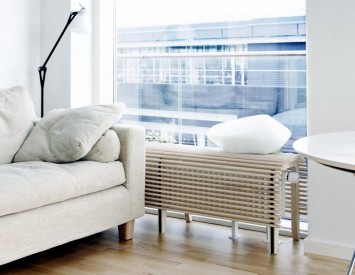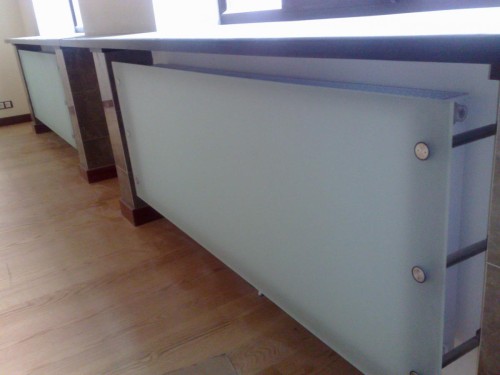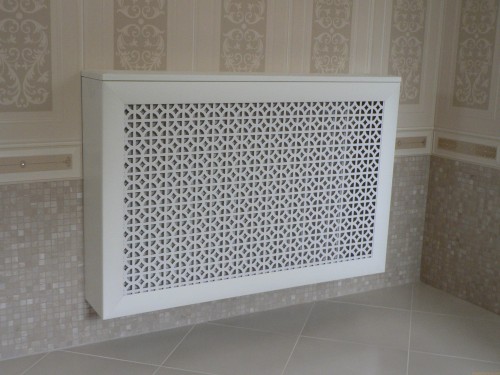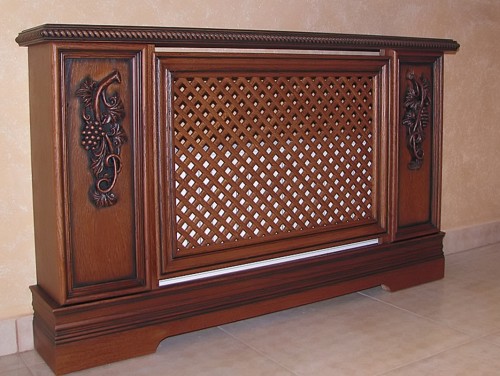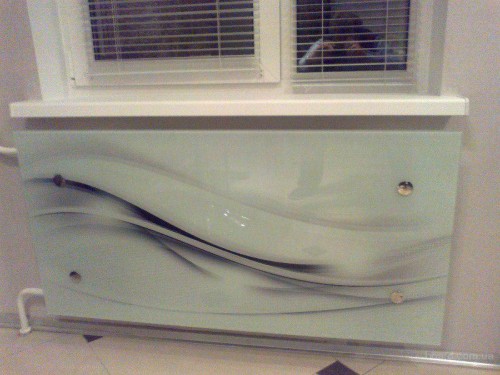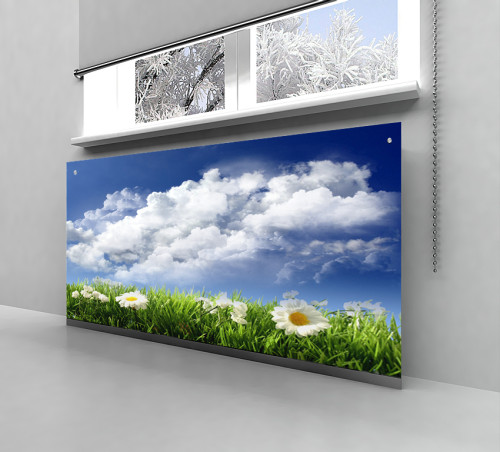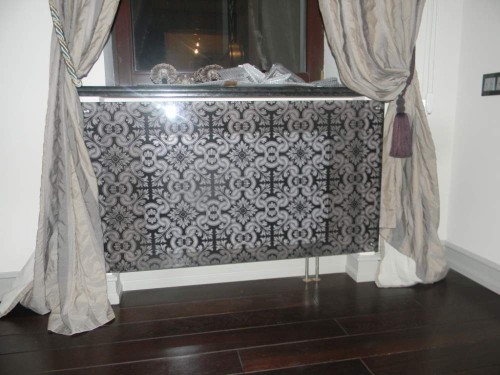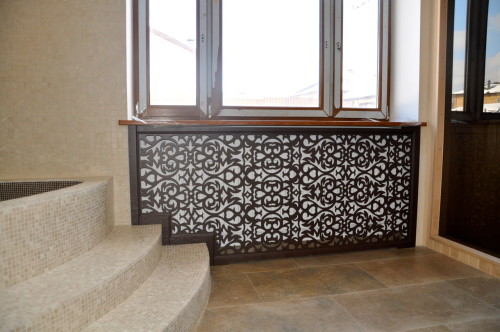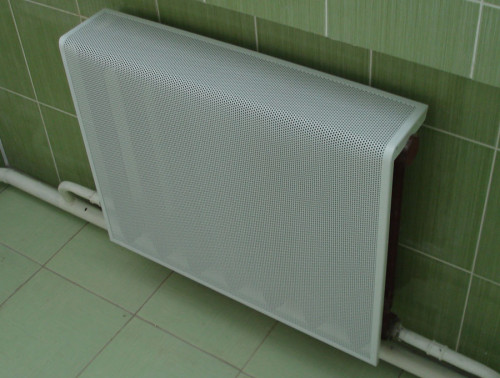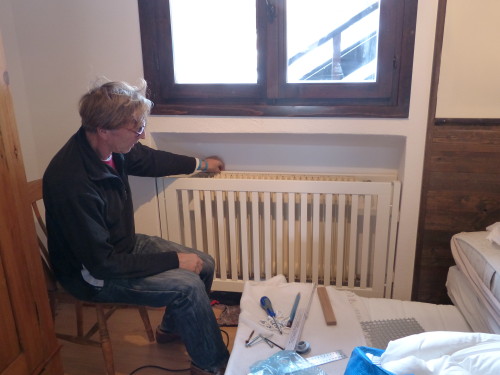Screens for heating batteries are an indispensable element of the interior, without which it is impossible to give the room a complete look. Without the use of such gratings, the room will look unattractive, which means that there is a need to purchase and install this decorative element.
Content
Decorative screens for heating batteries are presented in the construction market in a wide range. Popular protective devices are made of inexpensive materials. For example, the screens from the MDF fit perfectly into the interior of any room. But we do not stop your choice on this, we recommend that you familiarize yourself with models, screens designed not only to protect heating batteries in the rooms. You can also choose the right option for cafes, restaurants, hotels, etc.
What are the screens for?
Give tribute to fashion or understand the significance of this small interior detail? Everyone must decide for himself, we will consider several options that will help us choose the right screen for heating batteries.
The purpose of the gratings:
- Improve the aesthetics of the room. Place accents and hide unpresentable batteries located in a prominent place.
- Protect people from burns. This is especially true in children's institutions, cafes, restaurants, for families with young children.
- Installation of the screen will facilitate care, especially if the old -style radiators are installed in the room. It is very difficult to wash them, as dust clogs into narrow lattices.
Protective screens for batteries. Types
For heating radiators, the “Soviet” sample or new models should be selected by a protective screen. It will hide boring monotonous aluminum radiators of white color, and will also successfully fit into any interior of the room.
When we make repairs in the room, we try to think over everything to the smallest details. We select the material of the walls of walls, ceilings and floor in one color scheme. After completing the repair, it is also necessary to solve a difficult problem, because it is necessary to choose furniture, curtains, lighting devices. In the interior, everything should be in harmony. How to regret when heating radiators, even modern ones, are striking. If you immediately think about this moment during the repair process, then you can order an exclusive product that will fit under the design of the room. But, you can stop there, because not everyone can afford to pay for expensive exclusive heating radiators. There is a way out - you can purchase special protective devices for heating batteries that will be in harmony with the interior of the room.
So, we came to the understanding that protective devices for heating radiators should be beautiful. But this is not enough. The heating season in Russia lasts at least 6 months, or even more. It is clear that all this time the screen will be in close contact with the air flow. So, he must have protective properties.
Screens can be made of these materials:
- plastic;
- stainless steel;
- wood;
- glass;
- MDF.
Plastic screen
Plastic screens on the battery have a low price and low weight. On this the positive properties of the device end. When purchasing such a screen, there is a chance to buy a protective device made of low -quality materials. When heated, plastic can distinguish harmful pairs, and if the radiators are too hot, then even melt.
Advantages of plastic panels:
- ease;
- low cost;
- suitable for household premises, hospitals, offices.
Flaws:
- releases toxins when heated;
- wear out quickly;
- it looks cheap;
- due to the release of toxins of the room, you need to constantly ventilate.
Metal for the screen
Metal screens for batteries were invented in the 19th century. The first models were made of thin sheet steel. The main advantage of such linings is inexpensive cost. Among the minuses, primitiveness should be noted.
An interesting option that looks good and harmonizes with the interior of the room - a stainless steel grill with holes.
Among the advantages of metal protective grilles can be distinguished:
- good heat transfer;
- lightness in care;
- the air circulation improves and the room heats up quickly and evenly;
- reliably protected from pollution;
- just remove;
- easy to wash;
- do not change color and shape.
There is only one drawback - they are suitable only for the design of the room, made in the style of “techno” or “high tech”.
Wood for the screen
Wooden screens for batteries are a classic version of protecting heating radiators. They have good heat transfer. In the manufacture of wood from wood, different wooden breeds can be used, and the ability to cover the product with the desired shade of varnish or paint will make an individual screen. The main advantage of such gratings is that they are suitable for any interior style.
Popular lattices for heating radiators are popular this year - from rattan wood. This is a dried stalk of tropical vines, processed by steam. As a result of processing, the stems are dried and subsequently not exposed to deformation. The material consists of several layers, elastic, therefore it can take any shape. The main advantage of this material is lightness and security for humans.
The advantages of wooden grilles for radiators:
- aesthetics;
- environmentally friendly material;
- high heat transfer;
- harmonize with the interior and wood furniture.
Of the shortcomings, it is worth noting the high cost of products. Behind wooden grilles, it is necessary to carefully care and take into account that wood is a soft material, so it can be deformed over time.
Glass for the screen
Glass screens for batteries are made of hardened or stained glass. The thickness is within 8 mm. Such screens are used to decorate exquisite interiors. The glass is not subjected to mechanical stress, that is, it cannot be damaged, since it is placed in a protective film. It also protects glass structures from cracks and blows. The corners have a rounded shape, which allows you to install screens even in the children's room.
You can clean glass screens for heating radiators with liquid detergents. If you want to purchase protection for glass batteries, but you can’t afford it because of the high cost, pay attention to budget models made of acrylic glass. Such screens will be a little thicker. You can choose a matte or translucent surface. Acrylic glass is represented in a wide color range, which allows you to choose a shade suitable for the interior of the room.
Another type of glass screens for heating radiators is the triplex system. These are multi -layer screens made of several layers of thin glass, fastened together with polymeric materials. The common name is a stained glass panel.
There are such varieties of glass stained glass screens:
- With photo printing is the main advantage of glass screens. Thanks to this possibility, a beautiful pattern, landscape, a panorama of the city or an image of animals and even loved ones appear on the site of an unsightly heating radiator. It all depends on your imagination.
- The pattern with silicate colors - the artist applies the pattern you have chosen, which is then burned in the furnace at high temperature. As a result, the resistance of the coating will be very high.
- Processing the glass surface with a stream of sand with air, plus adding paints. You will get an exclusive pattern called "sandblasting."
- Fuzing, when dozens of small glass fragments are laid out on the glass surface, forming a certain pattern. Then they are baked in the furnace at high temperature. The result is interesting patterns.
- Tiffany is a method that won the hearts of many art lovers. The glass surface is treated with glass cutter, then a copper film is laid out according to the pattern. Elements are collected by solder (copper with tin). The result is a chic pattern. The cost of such a glass screen is very high.
- Molting technology is the formation of glass in hot condition. Using such a technique, any form can be achieved.
- Mating or etching of a glass surface - a pattern or pattern is applied to the surface and scratched with a special sharp tool.
- Facetic method - robbed fragments of glass are impregnated with glue and glued into a metal frame. For decor, rhinestones, and artificial stone are used. As a result of painstaking work, glass screens for batteries will be very strong, they are not afraid of temperature fluctuations.
- Film stained glass. In the manufacturing process, a lead film is used. Such a glass surface looks very beautiful, but has a high cost.
Pros of glass grilles:
- ease;
- large selection;
- exclusiveness.
Of the shortcomings, the high cost of the product is distinguished, the need for care. In addition, glass screens prevent normal air circulation between the heating battery and the window, as a result of which condensation appears.
Screen from MDF
Boxes from MDF (pressed sawdust). It is not deformed under the influence of hot air and high humidity. A box is built from the MDF sheet, and the front part is made of wood or plastic. If the MDF grille is continuous, normal heat transfer will be disturbed. It is better to choose a design with holes.
What are the advantages of MDF grilles:
- does not deform;
- the insert can be replaced with another;
- low price;
- ease of installation;
- simplicity of service.
Cons:
- if the insert does not meet the above requirements, then heat will remain inside;
- after installing the MDF box, it is impossible to wash the radiator.
Hinged screens for batteries
When choosing a screen for a cast -iron battery, you need to pay attention to the design.
Types of gratings:
- flat, for radiators located in a niche;
- box, when you need to hide the battery along with communications in the box;
- hinged screens without lid for heating devices located under the windowsill for protruding radiators - hinged structures with a lid.
Hinged grilles are very popular among owners of country houses and apartments. Brights for batteries reduce the harmful effects of infrared radiation, and also do not interfere with normal circulation of air flow.
It turns out that the screen for heating radiators is a kind of boundary that divides 2 air streams (cold and hot) and improves circulation. In addition, the hinged lattice protects against burns, abrasions and blows, especially if small children grow in the family. They prevent the accumulation of dust in those places of the radiator, which are difficult to get to in order to wash the battery qualitatively. To clean the screen itself from dust and pollution, it is necessary to unscrew it and rinse under a stream of warm water. You can use liquid detergents. It is not necessary to paint screens for heating batteries, since they are covered with special heat -resistant paint.
How to install a screen
Everyone will cope with the installation of the protective canvas. You need to carefully read the instructions and deal with the mounting element. Some screens are simply hung on screws like a mirror, and some are “put on” on special clamps. In any case, it is necessary to make markings in advance on the wall for fasteners. There are also models that do not need to be specifically fixed. They sit on the radiator itself, thanks to their curved form.
Convenient and practical lattices are hinged. To perform installation, it will take only a few seconds. This facilitates care, because at any moment you can remove the protection to wash it.
The hinged screens are durable and aesthetic and, probably, this is why they always are in demand.
As we know, the lattice performs 2 functions: protective and aesthetic. The speeches that screens contribute to effective heat transfer and improve the heating of the room cannot be. But we can independently affect this process and improve heat transfer by installing a reflecting element between the radiator and the wall. If you have enough space, then you can attach foil on the foam or glue it to glue. Then we can talk about improving heat transfer not only in residential premises.
